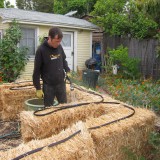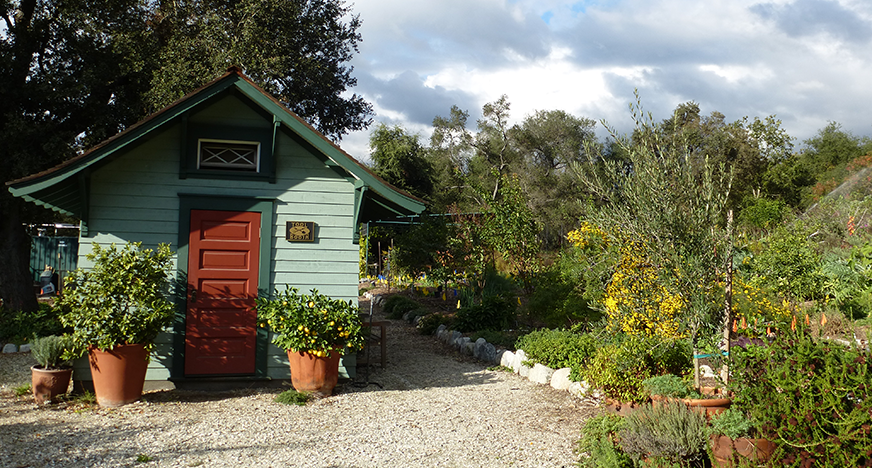
Cornell University illustration showing biochar as a means of sequestering greenhouse gases.
I’m always skeptical of what I call the “notions and potions” school of gardening. Every few years there is some new substance touted as the secret to a lush vegetable garden. One such substance is biochar, a kind of charcoal used as a soil amendment.
The University of Minnesota Extension service is in the midst of a four year study to test the use of biochar in vegetable gardens.
Preliminary results (which you can read here) show benefit for some crops such as kale, but a decrease in growth for others such as asparagus.
The more we learn about biochar, the more we need to learn. From an overall standpoint, there appeared to be some benefit of using biochar in the nutrient-depleted sandy soils at the Andover site for some crops. Yet, there was a decrease in growth in some plants and higher yield in others. In the Arboretum and St. Paul campus sites, we noted similar results, but more crops seemed to decline with biochar than without it.
There’s nothing new about biochar. It was in use by native peoples in the Amazon region before Columbus. Hopefully this study will help clarify what types of soils and what crops benefit most from its use.
Do you have an opinion about Biochar? Leave a comment . . .
And thanks to Michael Tortorello for sending me the link.






I’ve been learning about biochar for several years now and this much I can say; it can provide many benefits under a variety of different conditions, but there are a lot of generalizations floating around with much hyped expectations which may or may not prove out under different growing conditions.
All of the biochar trials are using different types of feedstock and different cooking temperatures which create different biochar properties, and then they test it on different soils on different plants with different application rates. Not surprisingly they get different results! So I agree with ‘the more we learn, the more we need to learn’ statement!
Interesting. From everything I’ve read about biochar though, it didn’t sound like they used it correctly. The way I understand how biochar works is that its structure is very porous, so it has a large surface area that holds whatever it’s been inoculated with, and that some sort of inoculation is necessary for it to work. It can be inoculated with compost or urine- just about anything as long as it something you want in your garden soil.
It sounded like they had a lot of issues with these tests, and I’m doubtful they were conclusive. It’s interesting that they had such varied results from one crop to another though.
I haven’t looked at the study but Paula’s comment above is on point: biochar has tremendous surface area that can act as a reservoir, for nutrients and for water. So if it’s not inoculated before application then it may decrease the availability of nutrients.
Biochar is benefitting from many demonstration projects worldwide with many feedstocks and in many soil types. See my website for an introduction.
It seems, to me, less a way of improving arable land than of making land arable that had not been. It’s the only way I know of to permanently change soil texture without importing resources to the site, and I’m not surprised by the preliminary results that biochar is more beneficial to sand than to loam.
I’d be interested to see a trial on outright clay. I think the ancient sites were bauxite “soil”, such heavy clay that potsherds were a worthwhile soil amendment. The worthwhile metric there wouldn’t be how much can be produced, but how soon after a rain one can hoe/plow.
We always dumped all of the ashes, etc from our stove in the garden.Whether that is a true bio char, i dont know. but it didnt seem to hurt anything.
I am not as familiar with inoculation or with garden trials, but as an archaeologist who has worked in the tropics, I know a little about biochar from that angle. One thing is that along with the burned and half-burned woody material, soil around a human settlement generally gets doses of pee and poop, broken pots, mollusc shells and animal bones (not to mention feathers, exoskeletons, scales, and inedible parts of food plants). The organic materials going into the black soil of the Amazon or any other midden can be pretty diverse. I can see how this organic input would be more noticably beneficial in heavy clay or structureless sand than it would in a loam.
The charred material is very stable and can stick around for thousands of years, which is why archaeologists often do radiocarbon dates on it, and why putting charcoal in the soil has promise for carbon sequestration.
To appreciate the wider applications of Biochar, the use as a feed additive and nutrient management tool, Please review my presentation and slides of this opening talk for the USBI Biochar conference in Sonoma California. This is the third US Biochar conference, after ISU 2010 and Colorado 2009;
“Carbon Conservation for Home, Health, Energy & Climate”
http://2012.biochar.us.com/sites/2012.biochar.us.com/files/presentations/ErichKinght.pdf
Modern Thermal conversion of biomass burns only the hydrocarbons in that biomass, conserving the carbon for the soil. At the large farm or village scale modern pyrolysis reactors can relieve energy poverty, food insecurity and decreased dependency on chemical fertilizers.
Please take a look at this YouTube video by the CEO of CoolPlanet Biofuels, guided by Google’s Ethos and funding, along with GE, BP and Conoco, they are now building the reactors that convert 1 ton of biomass to 75 gallons of bio – gasoline and 1/3 ton Biochar for soil carbon sequestration.
http://www.youtube.com/watch?v=zkYVlZ9v_0o
If CoolPlanet Biofuels processed the entire projected US biomass harvest in 2030, of 1.6 Billion Tons, the yields would be;
120 Billion Gallons of tank ready fuel ,(The US uses 150 Billion gallons/year), and 0.3 Billion Tons of Biochar
The big numbers are jaw dropping,
The 0.3 Billion Tons of Biochar, with a surface area of 400 m2/gram means; One Ton has a surface area of 98,000 Acres!
Now for conversion fun: 98,000 Acres is equal to 152 square miles!! ….
So; 300 Million Tons of Biochar equals 45 Billion Square Miles, or 230 times the entire surface of the earth!
Costs; The field to wheel analysis is $1.50/gallon!
To review other developments in cleanburning cook stoves, pyrolytic home heating stoves etc. Please review my Sonoma Biochar Conference Report;
http://tech.groups.yahoo.com/group/biochar-policy/message/3921
“There’s nothing new about biochar. It was in use by native peoples in the Amazon region before Columbus.”
I’d be interested in seeing an authoritative source for this if you have one. So far as I have been able to ascertain black earths have been found at ancient living sites in the area, and these soils are regarded as highly productive by current inhabitants, but there is no evidence that biochar was “used” in any way, or even deliberately rpoduced, by those who originally lived in the settlements.
I’m working with a CSU researcher using biochar as a mitigation for root replant problems in peach trees. We’ve only just started the study so the results will not be available for a couple of years. It will be interesting to see how it transpires.
Demonstration, Using quantitative 13C nuclear magnetic resonance (NMR) spectroscopy measurements, concluding that both Terra Preta Soils and Midwest dark soils contain 40% to 50%+ of their organic carbon (SOC) as pyrolytic carbon char, that this pyrolytic carbon can account for all CEC
Abundant and Stable Char Residues in Soils: Implications for Soil Fertility and Carbon Sequestration
J.-D. Mao, R. L. Johnson, J. Lehmann, D. C. Olk, E. G. Neves, M. L. Thompson and K. Schmidt-Rohr
Environ. Sci. Technol., Article ASAP
DOI: 10.1021/es301107c
Publication Date (Web): August 20, 2012
Copyright © 2012, American Chemical Society
http://pubs.acs.org/doi/abs/10.1021/es301107c
Complementary to my focus on animal feed supplements as practiced by the European and Japanese companies, here is this latest in vivo study by Dr.Leng in Australia. This Black Revolution for agriculture could be fermented by our livestock. In the EU, 90% of the Biochar produced is passed through livestock before composting and field application. On Swiss Farms they have eliminated manure odor and closed the nutrient loop by retaining N in the Char/Compost. Dr. Ron Leng have shown cattle fed char reduced enteric methane emissions (40%), enhancing feed conversion (25%!), this has to be one the greatest advances in bovine nutrition in the last few decades.
http://www.lrrd.cipav.org.co/lrrd24/11/leng24199.htm
Australian market based instruments for increased soil carbon;
Soil Testing Protocols at the Padock Scale for Contracts and Audits
http://www.dpi.nsw.gov.au/__data/assets/pdf_file/0010/457228/Soil-testing-protocols-at-the-paddock-scale-for-contracts-and-audits.pdf
Further Information, For further information, about the Carbon Farming Initiative, please visit, http://www.climatechange.gov.au/cfi
Dr. Lal’s top cited paper;
Soil carbon sequestration to mitigate climate change
http://www.sciencedirect.com/science/article/pii/S0016706104000266
Re-Building the World’s Soil: The Role of Soil Carbon Methodology for U.S. and Global Carbon Offset Projects,
http://www.prweb.com/releases/2012/12/prweb10185341.htm
Modern Agriculture has evolved in the ability to remove the limitations to plant growth, from burning forest for ash fertilizers, to bison bones, to Guano islands, then in 1913, to crafty Germans figuring out how to suck nitrogen from the air to now with natural gas derived fertilizers. These chemical fertilizers have over come nutrient limits to growth for 100 years.
NPK and the “Green Revolution” in genetics have brought us to where we are, all made possible by basically mining soil carbon stocks. So we have now hit a carbon limit in two distinct ways. The first is continued loss of soil carbon content, the second is fossil carbon energy cost. The present farming system spends ten cents of fossil energy delivering one cent of food energy.
We can not go back, but we can go forward with our newly acquired wisdom.
Poor study.
Biochar must be conditioned with compost berfore adding to soil. “Working the soil to loosen it” was another mistake. You destroyed the microbial habitat.
i know that biochar can be madee from crop waste or uses crops that are grown for this purpose, and so does not impact current living plants. But if CO2 is the big enemy, and plants are consumers of CO2 as well, then why is it better to burn even plants grown for that purpose, when letting them live would have positive effects that might offset the logging of our forests? And another site questions Biochar’s viability as a carbon sink, but I am not sure which opinion is more accurate. Also, does it not seem like shortsightedness to believe that if a market is created for biochar, people would only use agricultural waste, and somehow not see the seemingly useless trees on their lands as a source of money? Especially in poorer countries, where even what seems like a low price to western nations is enough to bring down trees? I somehow feel as if this idea is trying to encourage something that will keep us tied to our current worldview in which we must burn some form of organic matter to produce energy, as if moving away from petroleum is so painful that we are only able to look to another similar substance that we will once again destroy environments to mass produce. It is not as if the only use for biochar, once well known, will be limited to use as soil amendment. Another by product of burning plants is syngas and bio oil, the latter supposedly being 60% of the yield when pyrolysis is done at higher temperatures. And that bio oil is already being researched for vehicle fuel. It sounds like the beginning of a very slippery slope in which we start logging trees in a frenzy to surpass the industrial era’s decimation of European forests. We have a lot more people now, and as gasoline becomes even more scarce, this industry will be poised as the cheapest alternative, and our shortsightedness will once again decide that forests are overrated anyway, and maybe we have too much land and too little sea, so why not cut all the trees down?